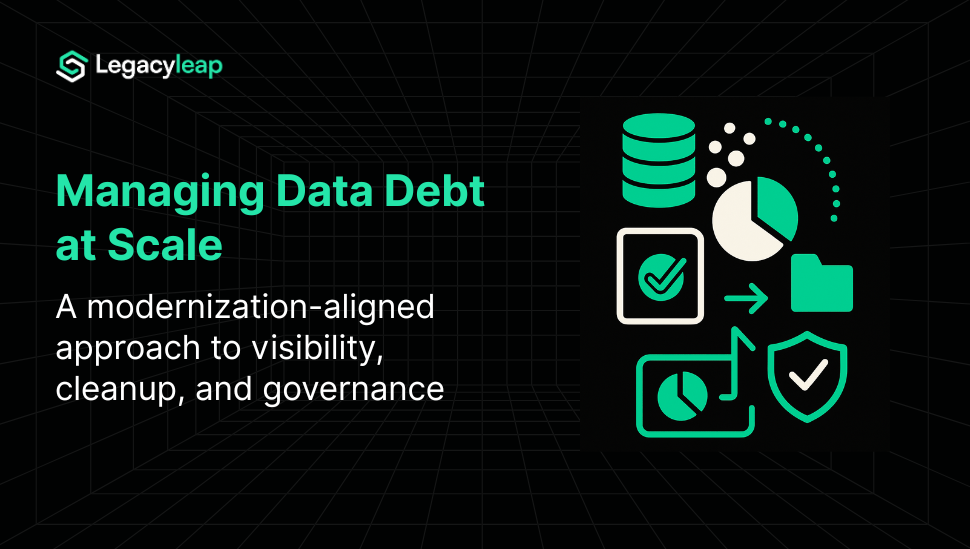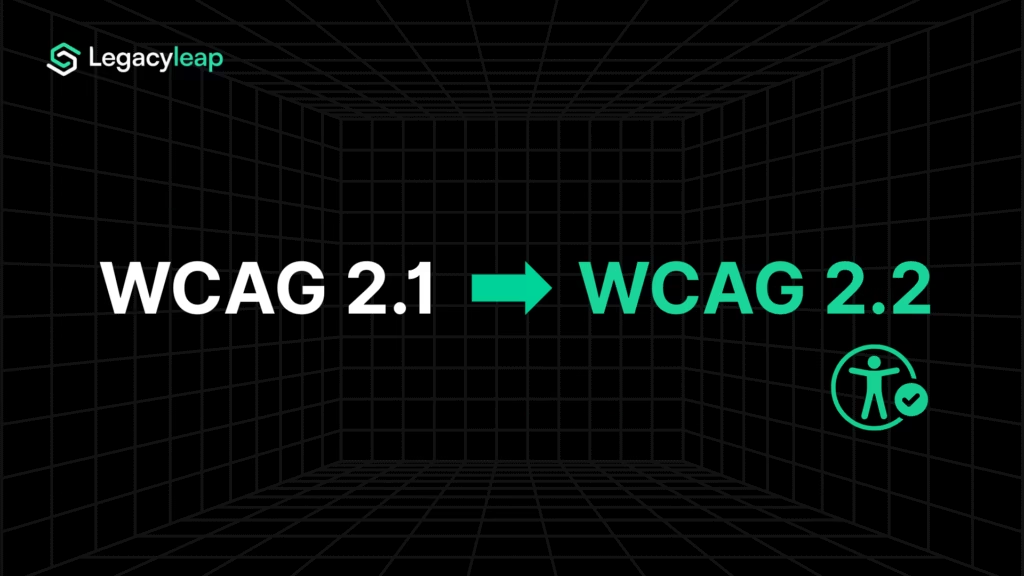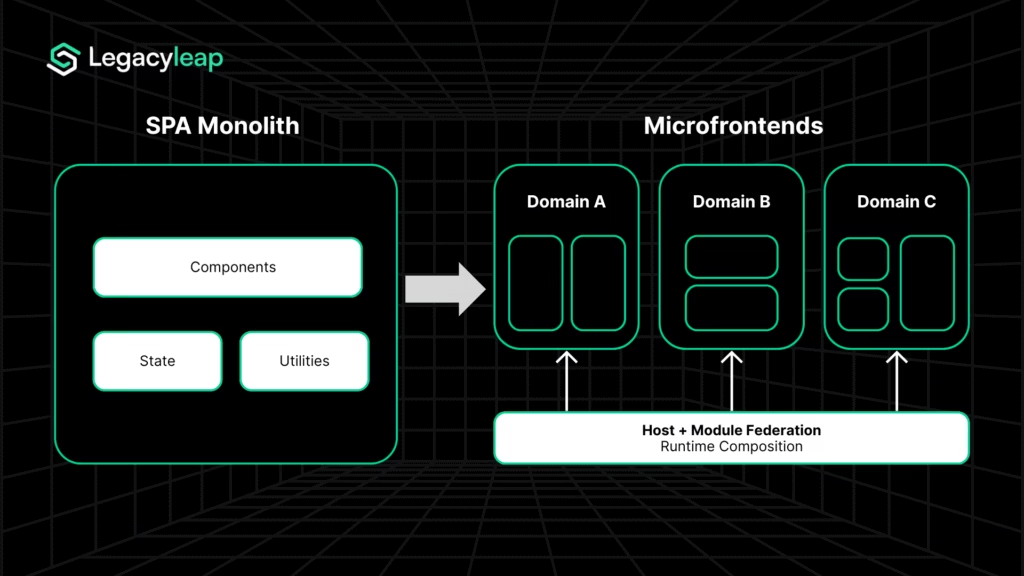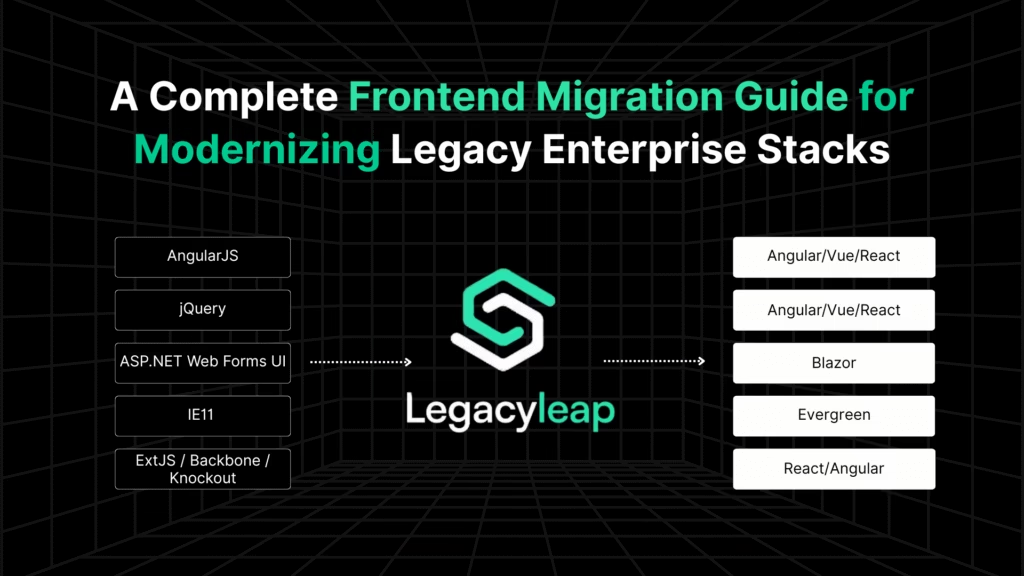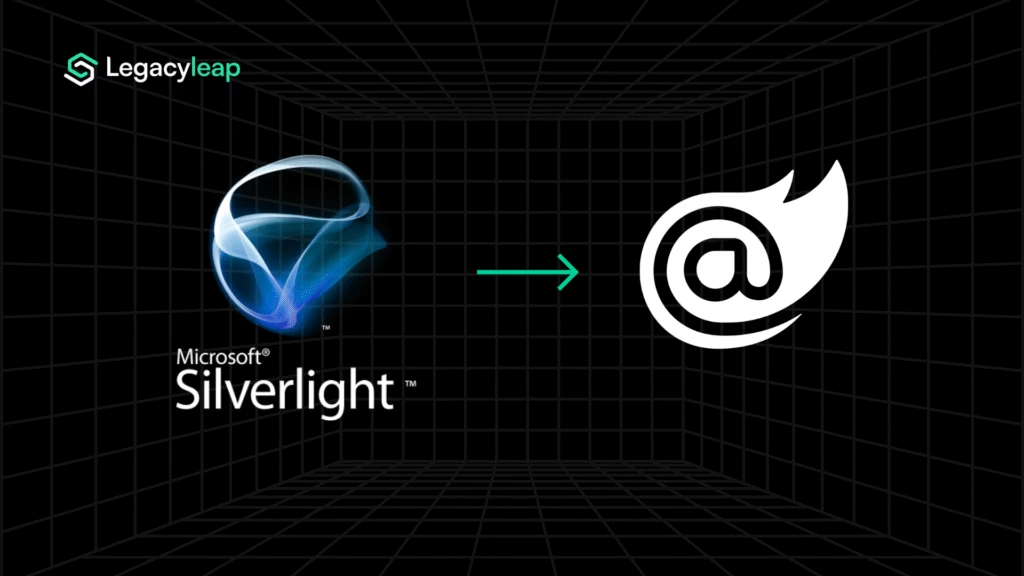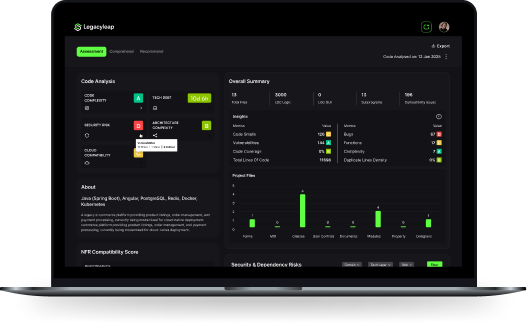Introduction: Before You Modernize, Audit Your Data Layer
Application modernization isn’t just about updating code, frameworks, or infrastructure. It’s about building systems that can scale, adapt, and integrate without friction. And for that to happen, the data has to be ready too.
Most organizations focus on technical debt – outdated code, legacy platforms, brittle architecture – but underneath it sits an equally critical and often ignored blocker: data debt.
Incomplete records. Conflicting definitions. Orphaned tables. Manual patchwork between systems. These are structural liabilities that make modernization riskier, slower, and more expensive.
This blog outlines how to treat data debt not as a cleanup task, but as a modernization dependency. You’ll learn how to identify it, measure its impact, and build the case for addressing it alongside, not after, your modernization roadmap.
What Data Debt Means in Legacy Systems and Why It Matters
Data debt is the accumulation of unresolved data quality issues, inconsistent structures, and unmanaged complexity in your data layer, often the result of years of tactical workarounds, rushed migrations, and poorly governed growth.
It shows up in many forms:
- Unreliable or conflicting source-of-truth systems
- Schema inconsistencies across environments
- Data pipelines with brittle dependencies
- Tables no one can explain but everyone is afraid to delete
Unlike technical debt, which is typically tied to code or architecture, data debt compounds invisibly. It’s easy to postpone until it blocks reporting, derails integrations, or injects risk into a migration.
Most data debt is unintentional. It grows when:
- New features bypass proper schema design
- Data transformations are hardcoded into pipelines
- Integrations happen without shared definitions or contracts
- Documentation is tribal, outdated, or missing entirely
The result? Modernization slows down not because the application is legacy, but because the data layer is unstable, misunderstood, or unfit to support change.
You can’t modularize, migrate, or rebuild systems cleanly on top of debt-ridden data. If you want modernization to scale, the data has to evolve with it, not lag behind.
If interested, check out this article on How to Identify and Address Technical Debt in Legacy Applications.
How to Identify the Symptoms of Data Debt in Legacy Systems
Data debt doesn’t announce itself, it shows up as friction. The warning signs are usually operational, not technical, and they often get dismissed as “just how things work.”
Here are some of the most common indicators:
- Inconsistent definitions across teams: One field, three meanings. Different departments use the same data differently, and no one’s sure which is canonical.
- Frequent reconciliation and patchwork fixes: Reporting requires manual cleanup. Business teams spend hours cleaning exports. The trust gap between systems grows with every cycle.
- High reliance on manual data handling: Automated pipelines break often, so people build spreadsheets to work around them. Institutional knowledge replaces documentation.
- Slow or painful integrations: Connecting new platforms takes longer than expected, not because of the app, but because the underlying data model can’t be cleanly mapped or extended.
- Schema drift and version chaos: There’s no single truth about how the data is structured, what’s current, or what’s deprecated. Breaking changes happen quietly.
These symptoms are easy to ignore until they start affecting delivery velocity, reporting accuracy, or the ability to onboard modern systems.
You can’t fix what you don’t see. Spotting the early signals of data debt is critical, not just for cleanup, but for protecting the integrity of your modernization efforts.
How to Quantify the Cost and Business Impact of Data Debt
You can’t fix data debt just because it feels messy. At enterprise scale, what gets funded is what gets measured.
Here’s how data debt shows up in real cost:
1. Operational Inefficiency
- Teams spend hours reconciling mismatched records or manually stitching reports together. Processes that should be automated remain manual.
Industry research shows poor data quality costs U.S. businesses an estimated $3.1 trillion annually, largely due to wasted resources, duplicated efforts, and errors cascading across systems
- Estimate the time lost per team, per function, per quarter, and convert it to FTE cost.
2. Delayed Modernization
- Migration efforts stall due to unresolved data discrepancies or unknowns in source systems.
- Calculate the timeline slippage on modernization projects caused by “data readiness” bottlenecks.
3. Quality and Risk Exposure
- Bad data feeds into critical systems: pricing, compliance, and personalization.
Forrester reported that enterprises lost millions in 2023 due to poor data quality, with the potential for billions more as AI adoption scales without intervention.
- Quantify the cost of a wrong forecast, failed SLA, or misfired campaign due to dirty or duplicate data.
4. Tooling and Integration Overhead
- Data debt increases the effort required to integrate with new platforms or vendors.
- Add up the cost of patchwork fixes, schema translation layers, and broken automation rework.
The real cost of data debt is that it limits what your teams can build, how fast they can move, and how safely they can evolve.
Why this matters:
Once you quantify the drag, it’s easier to prioritize remediation and easier to justify investing in governance, tooling, or transformation.
What Are the Best Strategies for Mitigating Data Debt in Enterprises
Fixing data debt isn’t about a one-time cleanup. It’s about building durable systems that stay clean over time. That requires discipline across people, processes, and platforms.
Here’s a practical approach:

1. Conduct a Targeted Data Audit
Start with a focused scan of high-risk systems tied to reporting, integration, or compliance. Look for:
- Redundant or orphaned tables
- Inconsistent schemas across environments
- Undefined fields in critical workflows
- High-volume manual overrides
Use these findings to score debt by impact and visibility.
2. Establish a Lean Data Governance Layer
You don’t need a steering committee, you need clear rules and owners.
- Define key business entities and standardize their definitions
- Assign ownership for source systems and schema changes
- Enforce versioning, access controls, and data contracts where feasible
The goal is to limit silent drift, not slow down teams.
3. Automate What Breaks Often
Invest in lightweight observability:
- Track schema changes across environments
- Flag data quality regressions
- Detect pipeline failures early
Tools like Great Expectations, dbt tests, or even custom alerts can reduce human firefighting.
4. Train Teams to Think in Data Contracts
Not everyone needs to be a data engineer. But product teams, analysts, and developers should:
- Know the upstream and downstream impact of changes
- Stop pushing schema changes without communicating them
Build with structure, not ad hoc queries.
5. Integrate with Modernization, Not After It
Data debt shouldn’t be an afterthought in your modernization project.
- Include remediation steps in your migration backlog.
- Track cleanup alongside refactors.
Let modernization sprints double as opportunities to resolve data issues that block scale.
Treating data like infrastructure — with visibility, ownership, and guardrails — turns debt reduction into a capability, not a fire drill.
How to Integrate Data Debt Management into Legacy Modernization Projects
Most modernization efforts focus on systems, services, and code. But if the data underneath those systems remains fragmented, undocumented, or untrusted, the project inherits that debt and multiplies it.
Here’s how to integrate data remediation directly into modernization:
Embed Data Cleanup in Modernization Sprints
Every service being modernized touches a data layer, whether through input validation, reporting, or downstream APIs.
Rather than treat data quality issues as separate “hygiene” projects, bake cleanup into the sprint scope.
This reduces context-switching and ensures long-term systems aren’t built on short-term data patches.
Modernize Interfaces, Not Just Code
When replacing a legacy module, it’s tempting to focus only on logic. But the way data moves in and out is just as important.
Use modernization efforts to:
- Redesign APIs with clearly defined data contracts
- Remove legacy fields that no longer serve a purpose
- Tighten alignment between storage models and business use
- This improves downstream interoperability and prevents new debt from forming.
Use Refactors to Collapse Redundancy
Legacy systems often duplicate data for convenience, not architecture.
Modernization creates a natural inflection point: if multiple systems store the same entity, decide which becomes the single source of truth.
This is your chance to reduce reconciliation overhead and consolidate scattered datasets into reliable, governed repositories.
Document as You Go
Data documentation is often skipped, delayed, or siloed. But during modernization, teams already have the system context in their heads.
Capture it while it’s fresh:
- Auto-generate schema descriptions
- Annotate transformations in pipelines
- Track lineage during migrations
Even minimal documentation can reduce future ramp-up time and support clean ownership transitions.
Leverage Gen AI for Legacy Data Mapping
For systems with minimal or no documentation, Gen AI models can accelerate analysis:
- Infer business logic from query patterns
- Identify unused fields or suspicious joins
- Suggest relationships between tables based on data shape and access frequency
Also read: How Can Gen AI Drive Every Step of Your Modernization Journey?
Used correctly, these tools can reduce weeks of manual mapping into hours of guided investigation.
Why this matters:
If you modernize the code but not the data, you’re just shifting legacy problems into newer systems. True modernization means updating what your systems do and how they know what to do with it.
Wrapping Up: Turning a Liability into an Asset
Data debt starts as an inconvenience. Left unmanaged, it becomes a constraint, not just on your systems, but on your entire organization’s ability to adapt and scale.
The upside? Unlike technical debt, which often requires heavy refactoring, data debt can often be resolved incrementally. Small, consistent efforts — audits, cleanups, governance practices — compound into long-term stability.
For technology leaders driving modernization, this isn’t just a cleanup task. It’s a dependency. And handled right, it becomes a catalyst:
- Clean data simplifies migrations
- Consistent structures accelerate integrations
- Trustworthy definitions reduce cross-team friction
Treat data debt like any other form of infrastructure debt: visible, measurable, and prioritized alongside the systems it supports.
At Legacyleap, our platform focuses on application code modernization, but it doesn’t ignore the data layer. From mapping schema dependencies to supporting selective data migrations, we enable modernization with visibility into how systems and data interact. And with security and oversight built in, teams stay in control as they evolve.
Ready to see how it works on your codebase? Reach out to us today for a $0 modernization assessment!
FAQs
Ignoring data debt during modernization leads to broken reporting pipelines, delayed deployments, and poor decision-making. Inaccurate, duplicated, or stale data from legacy systems can corrupt downstream analytics, complicate integrations, and stall cloud adoption efforts. Without addressing data quality, modernization projects risk becoming superficial replatforms instead of meaningful upgrades.
Your organization is ready to address data debt if you’ve identified key modernization goals (such as real-time insights, system modularity, or compliance) and recognize that poor data hygiene is a blocker. If you’re already running assessments on legacy systems or planning to migrate to a cloud-native or event-driven architecture, now is the time to integrate data debt analysis into your strategy.
Highly regulated and data-heavy sectors like healthcare, BFSI, manufacturing, and public sector are particularly affected. Legacy systems in these industries often rely on outdated data models, manual entry, or hardcoded logic, leading to severe duplication, compliance blind spots, and misaligned reporting structures that amplify data debt over time.
There’s no fixed number, but organizations should expect data debt remediation to account for 10–25% of the total modernization effort, especially in legacy-heavy environments. The cost varies based on data volume, system complexity, and remediation depth (e.g., deduplication vs. schema normalization), but integrating Gen AI-driven data assessments can significantly reduce manual overhead and costs.
The timeline depends on the size and complexity of your legacy landscape. With traditional methods, data remediation alone can take 6–12 months. However, with Gen AI-powered analysis, large enterprises can identify, classify, and act on data debt issues within 6–8 weeks, accelerating cleanup in parallel with application modernization.

